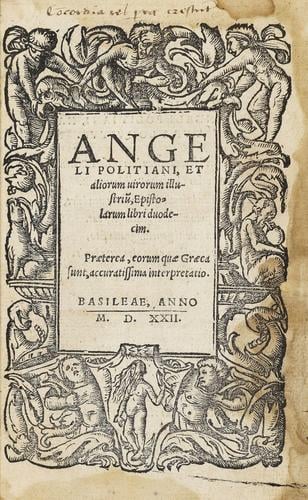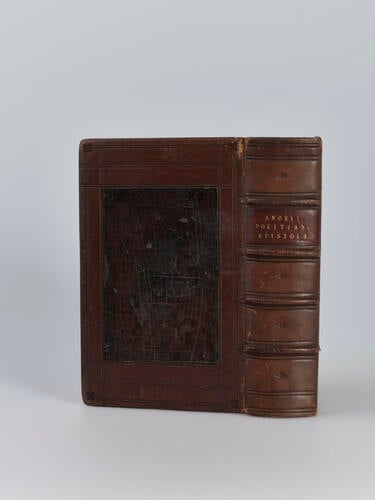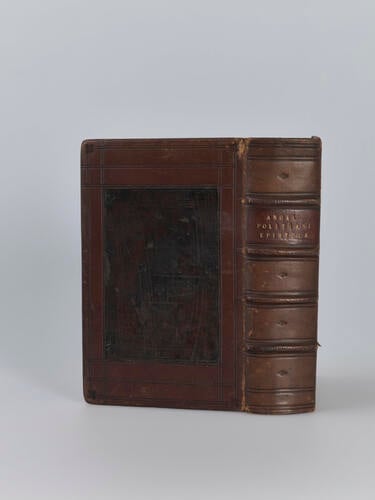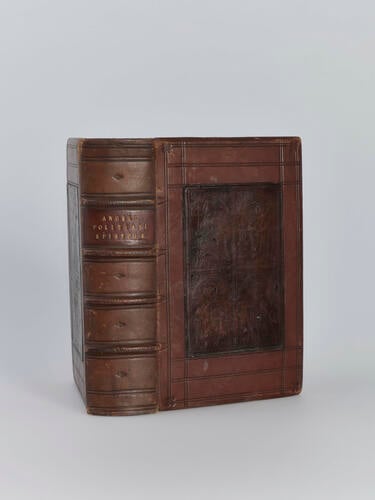-
1 of 253523 objects
Letters of Angelo Poliziano 1522
16.5 x 11.3 x 4.5 cm (book measurement (conservation)) | RCIN 1081338

Angelo Poliziano (1454–1494)
Angeli Politiani, et aliorum virorum illustrium, epistolarum libri xii 1522

Angelo Poliziano (1454–1494)
Angeli Politiani, et aliorum virorum illustrium, epistolarum libri xii 1522

Angelo Poliziano (1454–1494)
Angeli Politiani, et aliorum virorum illustrium, epistolarum libri xii 1522




-
Politian (Angelo Ambrogini, known as Politian or Poliziano) was one of the foremost Italian humanist scholars of the fifteenth century. Educated in both Latin and Greek from an early age, he was taken up by Lorenzo de’ Medici (1449-92) and made tutor to his children. He was noted for his poetry in both Latin and Italian, and his classical scholarship was in the best humanist tradition of textual purity, which led him always to seek out the earliest manuscripts in the original language that were available to him. His letters frequently followed the classical model of such authors as Cicero; they were not only private correspondence, but letters intended to be read by a more public audience, and designed to demonstrate his erudition and eloquence. Politian was in the process of preparing the corpus of his letters for publication when he died in 1494; the first edition appeared posthumously, published by Aldus Manutius in Venice in 1498, followed by later editions, based on Aldus’s own, from other printing houses both inside and outside Italy as late as the mid-seventeenth century. Erasmus was one of Politian’s early non-Italian readers, and derived several of his 'adagia' (or adages) from the letters to add to his collection (at the time of his death he had accumulated over 4,000 of them).
Holbein’s design for the title page of Politian’s letters was first made for a 1520 edition of the 'New Testament', edited by Erasmus and published by Andreas Cratander (active 1518-36). Cratander was originally from Strasbourg, and started in Basel as a proofreader for the printer Adam Petri (1454-1527), but later set up as a printer of humanist and classical texts, and some of the early works of Martin Luther. The woodblock was probably cut by Hans Herman, a German block cutter active in Basel from about 1516. Holbein’s design features two children flanking an old man in the centre top, and two children and two dolphins flanking Cratander’s printer’s mark - a naked woman with streaming hair set on a shield, to represent 'Occasio' or Opportunity. The vertical frame was made out of architectural features, with further figures on the central brackets: an animal on the left and a satyr playing the bagpipes on the right.
Not long after this book was printed at Basel in 1522, it was sold in the English market and bound, likely in London, by or for the unidentified bookbinder ‘G. R.’ Though heavily repaired in the nineteenth century, this volume retains its original blind-stamped panels (impressions of a complete pictorial design without further decoration to the leather) depicting four saints on the upper cover and the Royal arms on the lower cover. Such panels are typical of early sixteenth century English decorative bookbinding.
Catalogue entry adapted from The Northern Renaissance. Dürer to Holbein, London 2011.
Binding information
Rebacked and heavily repaired in the nineteenth century, incorporating early sixteenth century blind-stamped panels on dark brown calf (likely from the original binding). On the upper cover, a quadruple panel depicting (clockwise) St Claude, St Barbara, St Catherine, and St John the Evangelist (Oldham QUAD. 4), signed with the unidentified initials ‘G. R.’ in the last panel; on the lower cover, a panel with the Royal arms supported by a dragon and greyhound (Oldham HE. 34), signed with the same initials, and with a legend combining Psalms 92 and 11 (Vulgate); both within a double frame of fillets imitative of contemporary bindings. Spine with four raised (false?) bands, and anachronistic nineteenth century tooling; nineteenth century headbands. Textblock trimmed, rounded, and stained red. Original endpapers retained during repairs.
If the panels are original to the 1522 text, this may suggest an earlier use than was known to Oldham (see Blind Panels of English Binders, p. 25, where Oldham mentions fourteen known examples dated 1526–1535).
For another blind-stamped panel binding signed ‘G. R.’, see RCIN 1053840.Provenance
Historically believed to have been bound for Henry VIII. Previously owned by John Barkesdale, Thomas Willes and Samuel Clarke (active 1550-1600 but not yet identified); Rev. W.E. Buckley (1817-92); his sale, Sotheby's, London, 16-27 April 1894 (lot 3018), £1 8s; William Ridler, bookseller (active 1877-1904); acquired for the Royal Library by 1901. Bears the bookplate of Queen Victoria, used 1863-1901.
-
Creator(s)
(publisher)Acquirer(s)
-
Measurements
16.5 x 11.3 x 4.5 cm (book measurement (conservation))
19.0 x 5.5 cm (book in box)
16.5 x 4.5 cm (book measurement (inventory))
Markings
annotation: Underlining of text and notes in margins throughout in sixteenth-century hand, pen. [Throughout text]
Category
Alternative title(s)
Angeli Politiani, et aliorum virorum illustrium, epistolarum libri xii.
Place of Production
Basel [Switzerland]